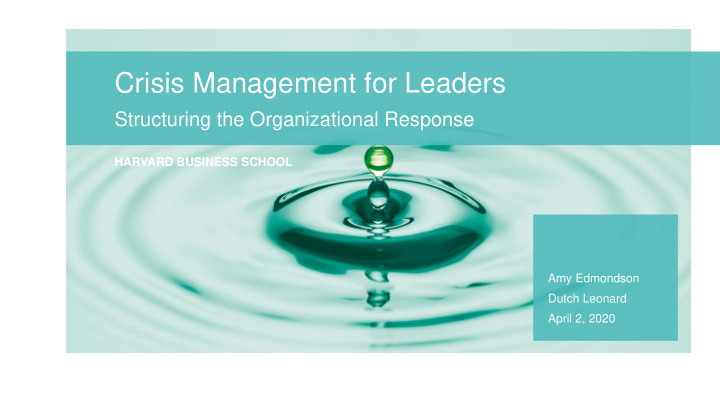



Crisis Management for Leaders Structuring the Organizational Response HARVARD BUSINESS SCHOOL Amy Edmondson Dutch Leonard April 2, 2020
Agile Teams to Navigate Uncertainty • Distributed leadership • Being directive about process • Psychological safety 2
Confronting A New Reality • Volatile: Rapid changes, ups & downs/big swings • Uncertain: Difficult to predict future events/values • Complex: Multiple interconnected elements • Ambiguous: Unclear meaning of signals/events = V.U.C.A. LEADERSHIP NEEDED… 3
The Wisdom of Teams… The Reality of Process Losses 4
Question • What might be keeping your team from doing its very best in response to this crisis? 5
Being directive about process: Some Tools 1. Assign a Devil’s Advocate 2. Shift to an Exploratory Mode 3. Adopt a Joint-problem-solving orientation 6
1. Assign a Devil’s Advocate Source: Waddell, Roberto, and Yoon, “Uncovering Hidden Profiles: Advocacy in Team Decision Making.” Management Decision . 2012. 7
3. SHIFT to an Exploratory Mode FRAME: Be explicit about the goal of problem-solving LEAD a discussion to consider: 1. What do we know about this situation? 2. What do we NOT know about this situation (and wish we knew)? 3. What are the implications of the above for our current (default) plan? If you identify uncertainties that cannot be resolved in the meeting, but must be better understand better, then: DESIGN a test: 1. Articulate a crucial question that could not be resolved with the information available 2. Brainstorm ways additional information could be obtained 8
Success in a Crisis Depends on Innovation Logic MANAGEMENT LOGIC INNOVATION LOGIC PRESCRIBE & CONTROL ENABLE & LEARN ASSUMES PREDICTABILITY ASSUMES UNCERTAINTY SIMPLE INTERDEPENDENCIES COMPLEX INTERDEPENDENCIES EMPHASIS ON EFFICIENCY EMPHASIS ON EXPERIMENTATION CLEAR SHARED CRITERIA MULTIPLE COMPETING CRITERIA HIERARCHICAL MONITORING & SUPPORT PEER MONITORING & SUPPORT How do you execute without a blueprint? 9
EXECUTION-AS-LEARNING • You face MANY unknowns • You must bring in different expertise at different times—without a clear line of sight about when and where • You lack a fixed set of metrics & deliverables • You often have to do things that haven't been done before • You have to act – to learn • …making progress through hypothesis, action, data, analysis, re-action… often encountering failures along the way 10
"FAIL WELL" Minimize Preventable Failures 1 • Where we know how to do it right; we have a playbook, yet deviations occurred… Anticipate & Mitigate Complex Failures 2 • Complex factors (organizational, market, natural) combine in completely new ways to produce failure in familiar contexts Pursue & Welcome Intelligent Failures 3 • Undesired results of thoughtful forays into novel territory (mission critical for innovation) 11
NONE OF US HAVE BEEN HERE BEFORE… 1. Call attention to that reality, often 2. Frame diverse perspectives as a resource 3. Create forums to build shared understanding and empathy 4. Ensure psychological safety for speaking up 12
Question (for reflection, but feel free to chat in your thoughts) • Who in your organization might feel inhibited from speaking up with concerns, questions, ideas, bad news, errors, and more? • What might make it hard for them to speak up? 13
To engage all of the ideas out there: make it safe to speak up Psychological safety is a belief that one will not be punished or humiliated for speaking up with ideas, questions, concerns, or mistakes. THINK OF IT AS FELT PERMISSION FOR CANDOR 14
“FEAR THAT IS SHARED IS LESSENED”* • As bad as things are -- we’re all truly in this together. • The fear most of us experience in this crisis is one we feel free to talk about with each other – and is not the same as feeling a lack of psychological safety in our normal work lives. • That feeling of all being in it together is characteristic of teams with high learning rates and, not coincidentally, high psychological safety. • Can we bring this new interpersonal openness and connection back to the organization in the future? * Kosner, A. https://blog.dropbox.com/topics/work-culture/amy-edmondson-on-the-power-of-psychological-safety-in-distributed work, March 27, 2020 15
A combination of clarity about what we are facing and psychological safety fosters a problem-solving response high PSYCHOLOGICAL Comfort Zone Problem-solving Zone SAFETY Apathy Zone Interpersonal Anxiety Zone low low high URGENCY 16
How do you build psychological safety? 17
Nurturing psychological safety to realize the potential of diverse expertise Set the Invite Respond Stage engagement appreciatively Set the stage by ensuring shared Responding in a way Inviting engagement by understanding of reality -- that embraces insisting on dissent and uncertainty, novelty, and messengers and asking good questions; possibility fosters learning 18
Question (chat in your response) HUMILITY EMPATHY CURIOSITY Set the Invite Respond Stage engagement appreciatively • As a leader in this unprecedented crisis, what are you doing in each of these domains? • What are you finding it most difficult to do? 19
FOOD FOR THOUGHT Framing : What will I do to clarify the importance of voice? How can I make sure everyone appreciates the uncertainty and interdependence we face, so they recognize the necessity of relating fearlessly to each other? Inviting : What can I do ask more, and better, questions, rather than just expressing my perspective? Responding : How will I signal that what I am hearing matters? What can I do to destigmatize bad news and intelligent failure? 20 20
Recommend
More recommend